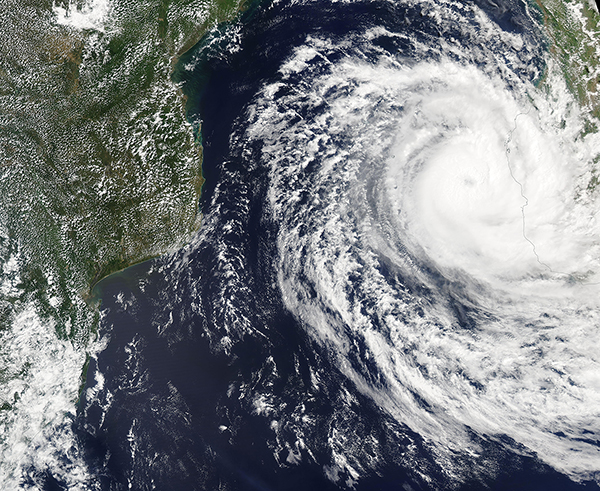Images
March 8, 2023 - Record-breaking Tropical Cyclone Freddy turns back to Mozambique
Tweet
After accomplishing a breathtaking long-distance journey that carried it over the Indian Ocean, Madagascar, and Mozambique, Cyclone Freddy simply won’t give up. It has spent most of the last two weeks careening like a pinball back and forth over the Mozambique Channel, creating chaos in both the island of Madagascar and the African country of Mozambique, where it brought extreme rains, flooding and at least 21 deaths between the two countries.
It has also racked up an impressive set of all-time records.
As of March 8, Tropical Cyclone Freddy appears to have captured the title of the longest-lasting tropical cyclone of all time, passing the 31-day record set by Hurricane/Typhoon John in 1994. The World Meteorological Organization (WMO) will open an investigation to confirm that record, but not until the storm has dissipated. The storm also set the record for all-time high accumulated cyclone energy (ACE), an index measuring wind energy over cyclone life. The WMO noted that Freddy’s super zonal track across the entire Indian Ocean is extremely rare, with only 2 cases recorded. Freddy also seems to have captured first place in rapid intensification, which occurs when wind speeds increase 35 mph or more within 24 hours. Freddy has undergone rapid intensifications six times—three more times than any storm in the Southern Hemisphere and two times more than any in the Northern Hemisphere.
Freddy became a named storm off the Australian coast February 6. It crossed the entire South Indian Ocean and made landfall in Madagascar on 21 February, crossed the island, then made landfall over Mozambique on February 24. Instead of dissipating over land, as expected, Freddy took a surprise turn to the east and once again found the Mozambique Channel, emerging as a weak tropical low on March 1. By March 5, Freddy was a tropical storm just off the coast of southwestern Madagascar, but by the next day it had spun northwestward across the Channel and began another round of rapid intensification.
On March 8 at 0300 UTC (March 7 at 10:00 p.m. EST), the Joint Typhoon Warning Center (JTWC) reported that Tropical Cyclone Freddy was carrying maximum sustained winds of 138 mph (122 km/h), which places it as a Category 4 storm on the Saffir-Simpson Hurricane Wind Scale. It was located about 53 miles east of Europa Island and was traveling northwest. Europa Island is a small atoll located about one-third of the way between southern Madagascar and southern Mozambique. The JTWC expects Freddy to weaken before making landfall on Mozambique on March 11.
The Moderate Resolution Imaging Spectroradiometer (MODIS) on board NASA’s Aqua satellite acquired a true-color image of Tropical Cyclone Freddy on March 7, shortly after it turned away from Madagascar (east) to make a return to Mozambique (west).
Image Facts
Satellite:
Aqua
Date Acquired: 3/7/2023
Resolutions:
1km (2.4 MB), 500m (6.6 MB), 250m (5.7 MB)
Bands Used: 1,4,3
Image Credit:
MODIS Land Rapid Response Team, NASA GSFC
Tweet
After accomplishing a breathtaking long-distance journey that carried it over the Indian Ocean, Madagascar, and Mozambique, Cyclone Freddy simply won’t give up. It has spent most of the last two weeks careening like a pinball back and forth over the Mozambique Channel, creating chaos in both the island of Madagascar and the African country of Mozambique, where it brought extreme rains, flooding and at least 21 deaths between the two countries.
It has also racked up an impressive set of all-time records.
As of March 8, Tropical Cyclone Freddy appears to have captured the title of the longest-lasting tropical cyclone of all time, passing the 31-day record set by Hurricane/Typhoon John in 1994. The World Meteorological Organization (WMO) will open an investigation to confirm that record, but not until the storm has dissipated. The storm also set the record for all-time high accumulated cyclone energy (ACE), an index measuring wind energy over cyclone life. The WMO noted that Freddy’s super zonal track across the entire Indian Ocean is extremely rare, with only 2 cases recorded. Freddy also seems to have captured first place in rapid intensification, which occurs when wind speeds increase 35 mph or more within 24 hours. Freddy has undergone rapid intensifications six times—three more times than any storm in the Southern Hemisphere and two times more than any in the Northern Hemisphere.
Freddy became a named storm off the Australian coast February 6. It crossed the entire South Indian Ocean and made landfall in Madagascar on 21 February, crossed the island, then made landfall over Mozambique on February 24. Instead of dissipating over land, as expected, Freddy took a surprise turn to the east and once again found the Mozambique Channel, emerging as a weak tropical low on March 1. By March 5, Freddy was a tropical storm just off the coast of southwestern Madagascar, but by the next day it had spun northwestward across the Channel and began another round of rapid intensification.
On March 8 at 0300 UTC (March 7 at 10:00 p.m. EST), the Joint Typhoon Warning Center (JTWC) reported that Tropical Cyclone Freddy was carrying maximum sustained winds of 138 mph (122 km/h), which places it as a Category 4 storm on the Saffir-Simpson Hurricane Wind Scale. It was located about 53 miles east of Europa Island and was traveling northwest. Europa Island is a small atoll located about one-third of the way between southern Madagascar and southern Mozambique. The JTWC expects Freddy to weaken before making landfall on Mozambique on March 11.
The Moderate Resolution Imaging Spectroradiometer (MODIS) on board NASA’s Aqua satellite acquired a true-color image of Tropical Cyclone Freddy on March 7, shortly after it turned away from Madagascar (east) to make a return to Mozambique (west).
Image Facts
Satellite:
Aqua
Date Acquired: 3/7/2023
Resolutions:
1km (2.4 MB), 500m (6.6 MB), 250m (5.7 MB)
Bands Used: 1,4,3
Image Credit:
MODIS Land Rapid Response Team, NASA GSFC




